Saturday 29 December 2012
Tuesday 25 December 2012
gun boats
I first saw "The Sand Pebbles" on television in 1976, and although in time I forgot the detail of the storyline, I remember well the emotional impact the film had on me.
I recently discovered an excellent site devoted to the film and this caused me to revisit it. It had lost none of its appeal, indeed I found it all the more interesting and thought provoking.
I consider it a gripping and important film with challenging ideas and observations, and in order to clarify my own thoughts, I wrote the following essay. I thought other fans of the film might find it interesting, though I am aware these are only my thoughts, and I have not sought to discuss aspects of the production of the film - I have limited myself to discussing what I see as its major themes.
I would be delighted to hear from anyone who would care to comment on the film or my ideas about it.
 If they carried more than one cannon, one might be a howitzer, for shore bombardment. They were usually not armoured.
If they carried more than one cannon, one might be a howitzer, for shore bombardment. They were usually not armoured.  The USS San Pablo described in Richard McKenna's The Sand Pebbles
The USS San Pablo described in Richard McKenna's The Sand Pebbles 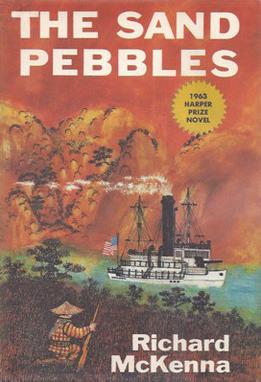 is an example of this class of vessel, serving on the US Navy's Yangtze Patrol. Stronger river warships were river monitors
is an example of this class of vessel, serving on the US Navy's Yangtze Patrol. Stronger river warships were river monitors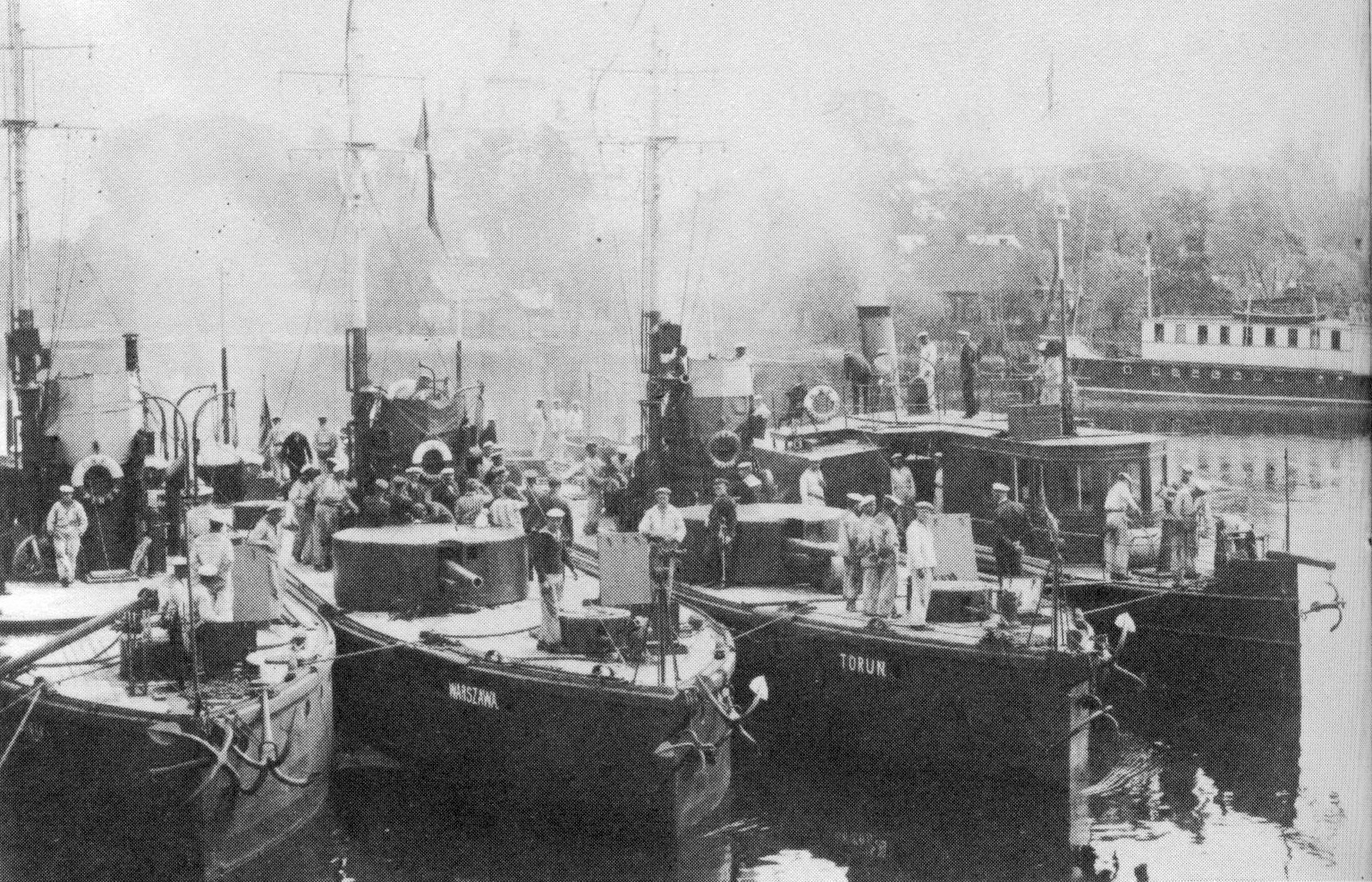
Various European powers, the USA, and Japan, maintained flotillas of these shallow draft gunboats patrolling Chinese rivers. These gunboats were enforcing those nations' treaty
 rights under the unequal treaties that China had started to sign following her defeat during the first Opium War with Britain.
rights under the unequal treaties that China had started to sign following her defeat during the first Opium War with Britain.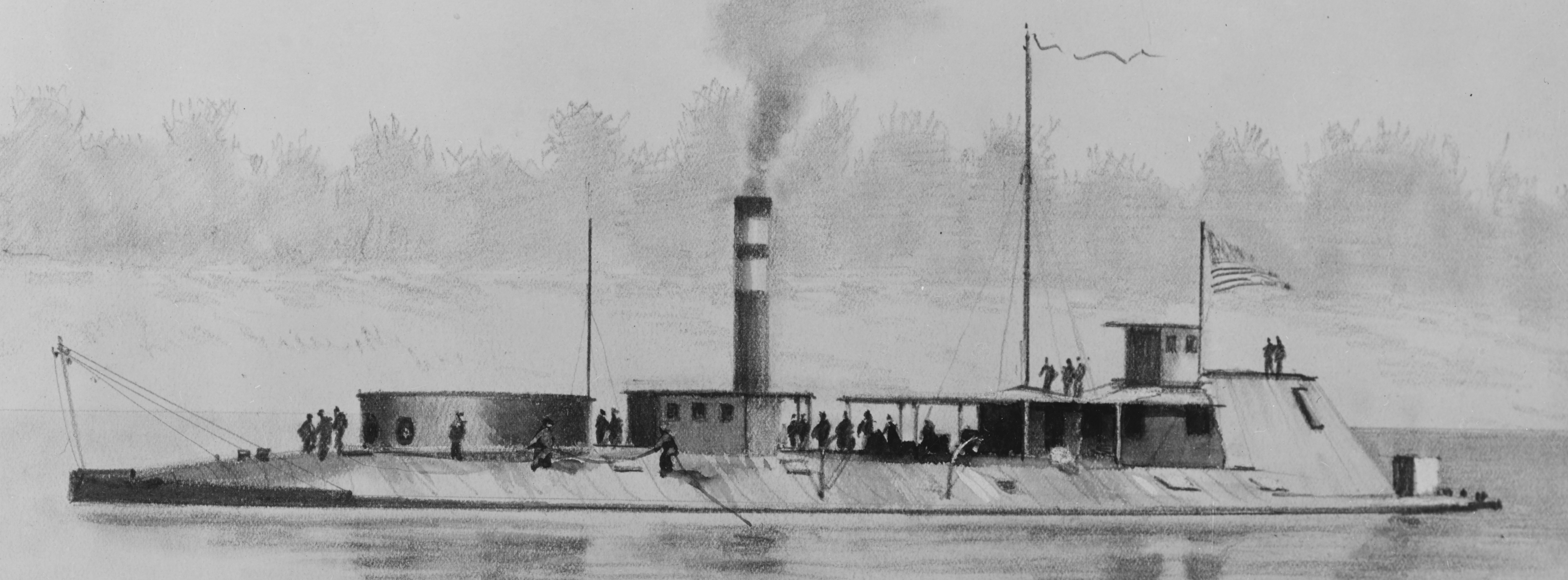
Foreign powers had coerced concessions from China, like extraterritoriality for their citizens in China, and the gunboats policed these rights.
Royal Navy gunboats, numbering on average 15 a year in Chinese waters, served as "station ships", assigned to specific ports, and were designed for river functions.
U.S. Navy craft were of varying age, design, size, and utility. The earliest craft made brief excursions upriver between 1861 and 1901, but were rarely assigned on permanent patrol. In 1901 two large gunboats, USS Helena (1290 tons and crew of 170) and Wilmington (1570 tons and 212), were assigned to the Asiatic Squadron's "Second Division" as permanent river patrol, although too large to patrol deep inland, until 1932 and 1923 respectively. In 1903 converted gunboats of the Spanish Navy captured in 1898, began patrols designed to take them further upriver toward Chungking. USS Elcano, a 620-ton craft with a crew of 103, and USS Villalobos, a 350-ton ship with 50 men, served until 1928, when they were decommissioned and sunk. USS Callao (240 tons) and Quiros (sister ship to Villalobos) served until 1916 and 1923.

In 1914 two 204-ton, 50-man patrol craft of British design and built at Mare Island Naval Shipyard were disassembled, shipped to China, and reassembled in Shanghai. USS Palos patrolled until 1934, when she became the station boat at Chungking, and Monocacy until 1939. The Yangtze Patrol was formally established in 1922 as a component of the Asiatic Fleet. Six new craft were designed and built in 1928 in Shanghai, of three differing sizes. USS Guam and Tutuilla, 380 tons and a crew of 60, were able to ply the entire river year round. USS Panay and Oahu, 450 tons and a complement of 65; and Luzon, 560 tons and 82 men, were "May-September" gunboats, able to patrol completely upriver only during high water months. (Luzon's sister ship, USS Mindanao served on the China coast but not in the river patrol.) Except for Panay, sunk by Japanese aircraft in December 1937, the newer ships served in China until l940
Thursday 20 December 2012
Saturday 1 December 2012
Saturday 24 November 2012
Wednesday 14 November 2012
Friday 9 November 2012
the ol barbed wire
If you want to find the Sergeant,
- I know where he is, I know where he is, I know where he is.
- If you want to find the Sergeant, I know where he is,
- He's lying on the canteen floor.
- I've seen him, I've seen him, lying on the canteen floor,
- I've seen him, I've seen him, lying on the canteen floor.

If you want to find the Quarter-bloke- I know where he is, I know where he is, I know where he is.
- If you want to find the Quarter-bloke, I know where he is,
- He's miles and miles behind the line.
- I've seen him, I've seen him, miles and miles and miles behind the line.
- I've seen him, I've seen him, miles and miles and miles behind the line.

- If you want the Sergeant-major,
- I know where he is, I know where he is, I know where he is.
- If you want the Sergeant-major, I know where he is.
- He's tossing off the privates' rum.
- I've seen him, I've seen him, tossing off the privates' rum.
- I've seen him, I've seen him, tossing off the privates' rum.
- If you want the C.O.,
- I know where he is, I know where he is, I know where he is.
- If you want the C.O., I know where he is
- He is down in a deep dug-out,
- I've seen him, I've seen him, down in a deep dug-out,
- I've seen him, I've seen him, down in a deep dug-out.
- If you want to find the old battalion,
- I know where they are, I know where they are, I know where they are
- If you want to find the old battalion, I know where they are,
- They're hanging on the old barbed wire,
- I've seen 'em, I've seen 'em, hanging on the old barbed wire.
- I've seen 'em, I've seen 'em, hanging on the old barbed wire
Sunday 4 November 2012
Saturday 3 November 2012
Friday 2 November 2012
the last gunfightld of the old west
He's back in The Last Gunfight, displaying
the impeccable research that is his trademark, to tell us what really
happened at the gunfight at the O.K. Corral on that cold October day in
1881. Doc Holliday. The Earps. They're all here.

Those who love a good old-fashioned shoot-em-up
Western might not be entirely happy with Guinn's storytelling. In short,
the romance is stripped away. Guinn's story is what really happened,
not what some Hollywood producer dreamed up. His research counters the
myth.

That said, this is still a terrific read, just as
Guinn's account of the deaths of Bonnie and Clyde was a terrific read.
Sometimes the truth is just as interesting as the fiction. Maybe more
so.
"What has come to be called 'the Gunfight at the
O.K. Corral' became a pivotal moment in American annals because
misunderstandings, exaggerations, and outright lies about it provided
impetus for future generations to form a skewed, one-dimensional view of
frontier history," Guinn writes.
He calls the real story of Tombstone, which was
then in the Arizona Territory, far more complex than a "cartoonish
confrontation between good guys and bad guys."
About the book
The Last Gunfight: The Real Story of the Shootout at the O.K. Corral - And How it Changed the American West
THE LAST GUNFIGHT
The Real Story of the Shootout at the O.K. Corral – And How It Changed the American West.
“A gripping revisionist account of the famed 1881 showdown. . . . Guinn uncovers complex figures who straddle the line between outlaw and lawman. . . . He sets the story in a Tombstone, Ariz., that’s a Wild West version of The Wire, complete with seething political intrigues. . . . Exhaustively researched, stylishly written . . . explodes many of the Manichaean myths surrounding the gunfight. . . As grimly compelling as a Greek tragedy.” — PUBLISHERS WEEKLYNew York, NY --(Ammoland.com)- Along with the Alamo and Custer’s Last Stand, the Gunfight at the O.K. Corral ranks among the most legendary battles of the Old West.
starred review “An absorbing, meticulous account of the famous O.K. Corral gunfight as it really happened. . . A great story.” — KIRKUS REVIEWS
Drawing on exclusive new material that completely reframes the event, Jeff Guinn – the critically acclaimed, New York Times- bestselling author of Go Down Together: The True, Untold Story of Bonnie and Clyde – gives for the first time a full account not only of what really happened, but of the personal and historical forces behind it, in the enormously entertaining and consistently eye-opening THE LAST GUNFIGHT: The Real Story of the Shootout at the O.K. Corral – And How It Changed the American West (Simon & Schuster; May 17, 2011; $27.00).
Like a classic Western movie, Guinn delivers a fast-paced narrative of high drama, featuring rustlers on the loose, sneak attacks, a love triangle, renegade Apaches, political tension, and the elegant, decadent frontier town of Tombstone, Arizona.

THE LAST GUNFIGHT by Jeff Guinn
At every turn, Guinn offers fascinating and illuminating new perspectives on the Tombstone story and its major figures, including:
- In his youth, Wyatt Earp was arrested for horse theft and broke out of jail while awaiting trial. Soon afterward, he also worked as a pimp in Illinois river towns. Even during his subsequent sporadic service as a policeman and deputy marshal (never as a full sheriff) in Kansas and Arizona, he was technically a fugitive from the law.
- How Doc Holliday and Wyatt Earp really became best friends for life. Guinn relates the whole story in Wyatt’s own words, told to a potential biographer whose notes have remained hidden by a private collector until they were made available exclusively for this book.
Moreover, Guinn contends, legends popularized by innumerable TV westerns and movies have distorted the way we view not only the O.K. Corral shootout, but the entire history of the Old West. As Hollywood would have it, for example:
- Western law enforcement mostly involved shootouts between sheriffs and bad guys on town streets at high noon.
- Everybody wore guns in fancy holster sets. Everybody drew fast and often.
- The West was a primitive place with rampaging Indians and comely schoolmarms, completely isolated from sophisticated culture.
- Nobility of purpose versus selfish disdain for others defined any conflict there. The lines between good guys and bad guys were clearly drawn. The spirit of the West was grounded in the simple desire to live in wild, wonderful places.
“What has come to be called ‘The Gunfight at the O.K. Corral’ became a pivotal moment in American annals,” Guinn writes, “because misunderstandings, exaggerations, and outright lies about it provided impetus for future generations to form a skewed, one-dimensional view of history. In fact, it represented an unintentional, if inevitable, clash between evolving social, political, and economic forces, though the Earps and the Clantons and the McLaurys and Doc Holliday had no notion of that when they began pulling triggers.”In addition, as Guinn recounts, the taciturn Wyatt Earp was responsible for many of the misconceptions about his own life. In a captivating coda, Guinn describes how Wyatt repeatedly tried to sell his story to book publishers and the movies until he died, nearly fifty years after the shootout. But he never succeeded, largely because his headstrong wife, Josephine, preferred that he be depicted as a true gentleman whose distinguished life only occasionally involved distasteful episodes with guns and frontier riffraff. After Wyatt’s death, Josephine reluctantly consented to work with the writer Stuart Lake, whose book about her husband became a surprise bestseller in the 1930s.
In his research, Guinn made numerous visits to modern-day Tombstone, which has reinvented itself as an Old West theme park. Now a year-round tourist mecca, the town holds a “Helldorado” festival every October to capitalize on its gun-slinging past. During 2009, an estimated 400,000 visitors flocked to Tombstone to ride around in stagecoaches, test their marksmanship in a shooting gallery, and, above all, pay $10 each to attend a reenactment of the gunfight where Wyatt, his brothers, and Doc blast Billy Clanton and the McLaurys into smithereens.
The shootout in Tombstone didn’t end anything, Guinn concludes, but many have come to consider it the last gunfight, the moment that defined the best of the wonderful Old West. Contemporary soldiers, athletes, and politicians routinely compare their victories to surviving the O.K. Corral. The image is rampant in our culture, and indelible. “As for Wyatt Earp, who was both more and less than his legend insists, we can feel certain of this: He would be pleased by the way everything turned out, except for the fact that he never made any money from it,” Guinn writes.
Anyone intrigued by one of the most romanticized episodes in America’s past will meet a West and a Wyatt Earp they never previously knew in Jeff Guinn’s riveting THE LAST GUNFIGHT. Combining masterly storytelling and memorable characters with authentic history and remarkable new revelations, it is the definitive work on the Wild West’s greatest shootout.
ABOUT THE AUTHOR
Jeff Guinn is the New York Times-bestselling author of twelve previous books of fiction and nonfiction, including Go Down Together: The True, Untold Story of Bonnie and Clyde, which was a finalist for the Edgar Award (true crime) in 2010. He is a former investigative journalist and books editor for the Fort Worth Star-Telegram, a member of the Texas Institute of Letters and the Texas Literary Hall of Fame and recipient of the City of Fort Worth’s Human Relations Commission’s annual award in 1999. He and his wife Nora are longtime residents of Fort Worth, Texas, and have two grown sons.
ABOUT THE BOOK
THE LAST GUNFIGHT: The Real Story of the Shootout at the O.K. Corral – And How It Changed the American West
Read more at Ammoland.com: http://www.ammoland.com/2011/05/06/the-last-gunfight-by-jeff-guinn/#ixzz2B57SqMQ5
By Jeff Guinn
Simon & Schuster, 384 pp., $27
Simon & Schuster, 384 pp., $27
What
readers will find is not only an interesting story of misdeeds and
misbehavin' — and a very brief gunfight — but a story well told, a
glimpse into daily life out West at the end of the 19th century.
Listen to Guinn's evocative description of the
times: "Dogs ran wild through the Tombstone streets and relieved
themselves indiscriminately. So did horses, and the mules pulling
freight wagons…Tombstone employed a town scavenger, but there was always
more rotting debris than one man could pick up. As a result, packs of
rats joined the ubiquitous desert scorpions and spiders in swarming
through town in alarming numbers. Even in fine new residences built of
adobe and wood, people fell asleep trying to ignore the scrabbling of
rodent paws nearby."
And then there's that little matter of a gunfight.
Thursday 18 October 2012
Tuesday 9 October 2012
Friday 21 September 2012
Wednesday 5 September 2012
Monday 3 September 2012
Thursday 30 August 2012
Wednesday 29 August 2012
Monday 27 August 2012
Sunday 26 August 2012
Tuesday 21 August 2012
Sunday 19 August 2012
soldier of the week.us machine gunner by barclay
Invented by Hiram S. Maxim in the U.S. in 1884, the Maxim Gun comprised the world's first automatic machine gun.
When war in Europe broke out in the summer of 1914 the major armies (bar France and Austria) largely made use of machine guns based upon Maxim's original design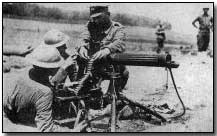

The Maxim Gun was water-cooled (via a jacket around the barrel which held approximately one gallon) and fed from fabric belts; the German version of the gun, the Maschinengewehr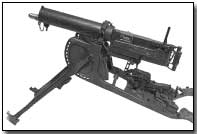 , utilised 250-round belts. The whole was mounted on a sledge which, although heavy - 1914 machine guns weighed from 40-60kg - did enable the gun to be carried in the manner of a stretcher. The Maxim was usually operator by a four to six man team.
, utilised 250-round belts. The whole was mounted on a sledge which, although heavy - 1914 machine guns weighed from 40-60kg - did enable the gun to be carried in the manner of a stretcher. The Maxim was usually operator by a four to six man team.
 , utilised 250-round belts. The whole was mounted on a sledge which, although heavy - 1914 machine guns weighed from 40-60kg - did enable the gun to be carried in the manner of a stretcher. The Maxim was usually operator by a four to six man team.
, utilised 250-round belts. The whole was mounted on a sledge which, although heavy - 1914 machine guns weighed from 40-60kg - did enable the gun to be carried in the manner of a stretcher. The Maxim was usually operator by a four to six man team.In designing his machine gun, Hiram Maxim utilised a simple if ingenious concept. The gas produced by the explosion of the powder in each cartridge itself generated a recoil which served to continuously operate the gun's mechanism. No external power was needed. His initial design allowed for a theoretical rate of fire of up to 600 rounds per minute (half that number in practice).
Maxim triumphantly demonstrated his new invention to, firstly, the British Army - he had moved to London shortly before developing the machine gun - in 1885. Two years later the British government placed an initial order for three of the devices for testing purposes. Although his invention passed all stipulated tests it was nevertheless not picked up the British; the military high command envisaged limited infantry use of the weapon.
Later the same year, 1887, Maxim's gun was demonstrated to the German Army. Kaiser Wilhelm II personally attended trials and, duly impressed, authorised its use. Thus the Maschinengewehr was born - a more or less direct copy of Maxim's invention; similarly the British Vickers 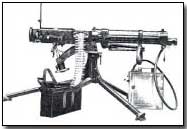 and the Russian Pulemyot Maxima
and the Russian Pulemyot Maxima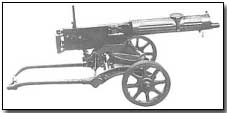 were also based upon the Maxim Gun.Having invented literally hundreds of items varying from a mousetrap to a gas motor Maxim received a knighthood from Queen Victoria in 1901. His company, the Maxim Gun Company, was later absorbed into Vickers Ltd., of which he became a director. The Vickers machine gun subsequently became the standard issue weapon of its type in the British army during the First World War.
were also based upon the Maxim Gun.Having invented literally hundreds of items varying from a mousetrap to a gas motor Maxim received a knighthood from Queen Victoria in 1901. His company, the Maxim Gun Company, was later absorbed into Vickers Ltd., of which he became a director. The Vickers machine gun subsequently became the standard issue weapon of its type in the British army during the First World War.
 and the Russian Pulemyot Maxima
and the Russian Pulemyot Maxima were also based upon the Maxim Gun.Having invented literally hundreds of items varying from a mousetrap to a gas motor Maxim received a knighthood from Queen Victoria in 1901. His company, the Maxim Gun Company, was later absorbed into Vickers Ltd., of which he became a director. The Vickers machine gun subsequently became the standard issue weapon of its type in the British army during the First World War.
were also based upon the Maxim Gun.Having invented literally hundreds of items varying from a mousetrap to a gas motor Maxim received a knighthood from Queen Victoria in 1901. His company, the Maxim Gun Company, was later absorbed into Vickers Ltd., of which he became a director. The Vickers machine gun subsequently became the standard issue weapon of its type in the British army during the First World War.Sir Hiram Maxim died in London on 24 November 1916, while the Great War was still raging, at the age of 76.
The Battle of Belleau Wood (1–26 June 1918) occurred during the German 1918 Spring Offensive in World War I, near the Marne River in France
Marne River in France . The battle was fought between the U.S. Second (under the command of Major General Omar Bundy
. The battle was fought between the U.S. Second (under the command of Major General Omar Bundy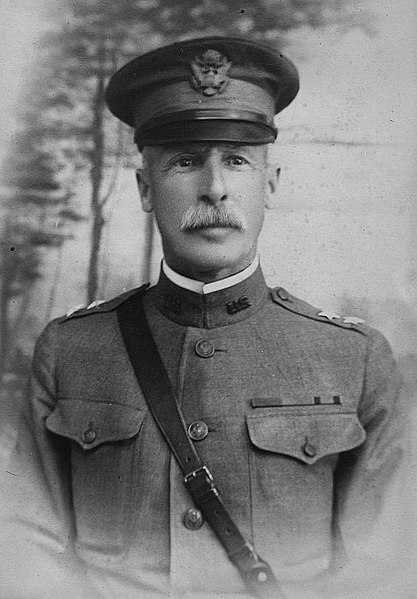 ) and Third Divisions and an assortment of German units including elements from the 237th, 10th, 197th, 87th, and 28th Divisions. The battle has become a deep part of the lore of the United States Marine Corps.In March 1918, with nearly 50 additional divisions freed by the Russian surrender on the Eastern Front, the German Army launched a series of attacks on the Western Front, hoping to defeat the Allies before U.S. forces could be fully deployed. In the north, the British 5th Army was virtually destroyed by two major offensive operations, Michael and Georgette around the Somme. A third offensive launched in May against the French between Soissons
) and Third Divisions and an assortment of German units including elements from the 237th, 10th, 197th, 87th, and 28th Divisions. The battle has become a deep part of the lore of the United States Marine Corps.In March 1918, with nearly 50 additional divisions freed by the Russian surrender on the Eastern Front, the German Army launched a series of attacks on the Western Front, hoping to defeat the Allies before U.S. forces could be fully deployed. In the north, the British 5th Army was virtually destroyed by two major offensive operations, Michael and Georgette around the Somme. A third offensive launched in May against the French between Soissons and Reims, known as the Third Battle of the Aisne, saw the Germans reach the north bank of the Marne river at Château-Thierry, 95 kilometres (59 mi) from Paris, on 27 May. Two U.S. Army divisions, the 2nd and the 3rd, were thrown into the Allied effort to stop the Germans. On 31 May, the 3rd Division held the German advance at Château-Thierry and the German advance turned right towards Vaux and Belleau Wood.
and Reims, known as the Third Battle of the Aisne, saw the Germans reach the north bank of the Marne river at Château-Thierry, 95 kilometres (59 mi) from Paris, on 27 May. Two U.S. Army divisions, the 2nd and the 3rd, were thrown into the Allied effort to stop the Germans. On 31 May, the 3rd Division held the German advance at Château-Thierry and the German advance turned right towards Vaux and Belleau Wood.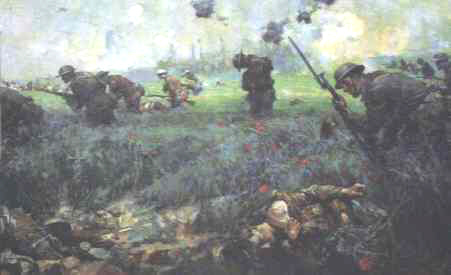
The Battle of Belleau Wood (1–26 June 1918) occurred during the German 1918 Spring Offensive in World War I, near the
 Marne River in France
Marne River in France . The battle was fought between the U.S. Second (under the command of Major General Omar Bundy
. The battle was fought between the U.S. Second (under the command of Major General Omar Bundy ) and Third Divisions and an assortment of German units including elements from the 237th, 10th, 197th, 87th, and 28th Divisions. The battle has become a deep part of the lore of the United States Marine Corps.In March 1918, with nearly 50 additional divisions freed by the Russian surrender on the Eastern Front, the German Army launched a series of attacks on the Western Front, hoping to defeat the Allies before U.S. forces could be fully deployed. In the north, the British 5th Army was virtually destroyed by two major offensive operations, Michael and Georgette around the Somme. A third offensive launched in May against the French between Soissons
) and Third Divisions and an assortment of German units including elements from the 237th, 10th, 197th, 87th, and 28th Divisions. The battle has become a deep part of the lore of the United States Marine Corps.In March 1918, with nearly 50 additional divisions freed by the Russian surrender on the Eastern Front, the German Army launched a series of attacks on the Western Front, hoping to defeat the Allies before U.S. forces could be fully deployed. In the north, the British 5th Army was virtually destroyed by two major offensive operations, Michael and Georgette around the Somme. A third offensive launched in May against the French between Soissons and Reims, known as the Third Battle of the Aisne, saw the Germans reach the north bank of the Marne river at Château-Thierry, 95 kilometres (59 mi) from Paris, on 27 May. Two U.S. Army divisions, the 2nd and the 3rd, were thrown into the Allied effort to stop the Germans. On 31 May, the 3rd Division held the German advance at Château-Thierry and the German advance turned right towards Vaux and Belleau Wood.
and Reims, known as the Third Battle of the Aisne, saw the Germans reach the north bank of the Marne river at Château-Thierry, 95 kilometres (59 mi) from Paris, on 27 May. Two U.S. Army divisions, the 2nd and the 3rd, were thrown into the Allied effort to stop the Germans. On 31 May, the 3rd Division held the German advance at Château-Thierry and the German advance turned right towards Vaux and Belleau Wood.
On 1 June, Château-Thierry and Vaux fell, and German troops moved into Belleau Wood. The U.S. 2nd Division—which included a brigade of U.S. Marines—was brought up along the Paris-Metz highway. The 9th Infantry Regiment was placed between the highway and the Marne, while the 6th Marine Regiment was deployed to their left. The 5th Marines and 23rd Infantry regiments were placed in reserve.
On the evening of 1 June, German forces punched a hole in the French lines to the left of the Marines' position. In response, the U.S. reserve—consisting of the 23rd Infantry regiment, the 1st Battalion, 5th Marines, and an element of the 6th Machine Gun Battalion—conducted a forced march over 10 kilometres (6.2 mi) to plug the gap in the line, which they achieved by dawn. By the night of 2 June, the U.S. forces held a 20 kilometres (12 mi) front line north of the Paris-Metz Highway running through grain fields and scattered woods, from Triangle Farm west to Lucy and then north to Hill 142. The German line opposite ran from Vaux to Bouresches to BelleauGerman commanders ordered an advance on Marigny and Lucy through Belleau Wood as part of a major offensive, in which other German troops would cross the Marne River. The commander of the Marine Brigade, Army Gen. James Harbord, countermanding a French order to dig trenches further to the rear, ordered the Marines to "hold where they stand". With bayonets, the Marines dug shallow fighting positions from which they could fight from the prone position. In the afternoon of 3 June, German infantry attacked the Marine positions through the grain fields with bayonets fixed. The Marines waited until the Germans were within 100 yards/metres before opening deadly rifle fire which mowed down waves of German infantry and forced the survivors to retreat into the wood.
and Lucy through Belleau Wood as part of a major offensive, in which other German troops would cross the Marne River. The commander of the Marine Brigade, Army Gen. James Harbord, countermanding a French order to dig trenches further to the rear, ordered the Marines to "hold where they stand". With bayonets, the Marines dug shallow fighting positions from which they could fight from the prone position. In the afternoon of 3 June, German infantry attacked the Marine positions through the grain fields with bayonets fixed. The Marines waited until the Germans were within 100 yards/metres before opening deadly rifle fire which mowed down waves of German infantry and forced the survivors to retreat into the wood.

On the evening of 1 June, German forces punched a hole in the French lines to the left of the Marines' position. In response, the U.S. reserve—consisting of the 23rd Infantry regiment, the 1st Battalion, 5th Marines, and an element of the 6th Machine Gun Battalion—conducted a forced march over 10 kilometres (6.2 mi) to plug the gap in the line, which they achieved by dawn. By the night of 2 June, the U.S. forces held a 20 kilometres (12 mi) front line north of the Paris-Metz Highway running through grain fields and scattered woods, from Triangle Farm west to Lucy and then north to Hill 142. The German line opposite ran from Vaux to Bouresches to BelleauGerman commanders ordered an advance on Marigny
 and Lucy through Belleau Wood as part of a major offensive, in which other German troops would cross the Marne River. The commander of the Marine Brigade, Army Gen. James Harbord, countermanding a French order to dig trenches further to the rear, ordered the Marines to "hold where they stand". With bayonets, the Marines dug shallow fighting positions from which they could fight from the prone position. In the afternoon of 3 June, German infantry attacked the Marine positions through the grain fields with bayonets fixed. The Marines waited until the Germans were within 100 yards/metres before opening deadly rifle fire which mowed down waves of German infantry and forced the survivors to retreat into the wood.
and Lucy through Belleau Wood as part of a major offensive, in which other German troops would cross the Marne River. The commander of the Marine Brigade, Army Gen. James Harbord, countermanding a French order to dig trenches further to the rear, ordered the Marines to "hold where they stand". With bayonets, the Marines dug shallow fighting positions from which they could fight from the prone position. In the afternoon of 3 June, German infantry attacked the Marine positions through the grain fields with bayonets fixed. The Marines waited until the Germans were within 100 yards/metres before opening deadly rifle fire which mowed down waves of German infantry and forced the survivors to retreat into the wood.Having suffered heavy casualties, the Germans dug in along a defensive line from Hill 204, just east of Vaux, to Le Thiolet on the Paris-Metz Highway and northward through Belleau Wood to Torcy .]After Marines were repeatedly urged to turn back by retreating French forces, Marine Captain Lloyd W. Williams of the 2nd Battalion, 5th Marines uttered the now-famous retort
.]After Marines were repeatedly urged to turn back by retreating French forces, Marine Captain Lloyd W. Williams of the 2nd Battalion, 5th Marines uttered the now-famous retort "Retreat? Hell, we just got here. Williams' battalion commander, Major Frederic Wise, later claimed to have said the famous words.
"Retreat? Hell, we just got here. Williams' battalion commander, Major Frederic Wise, later claimed to have said the famous words.

On 4 June, Maj. Gen. Bundy—commanding the 2nd Division—took command of the American sector of the front. Over the next two days, the Marines repelled the continuous German assaults. The 167th French Division arrived, giving Bundy a chance to consolidate his 2,000 yards (1,800 m) of front. Bundy's 3rd brigade held the southern sector of the line, while the Marine Brigade held the north of the line from Triangle FarmAt 03:45 on 6 June, the Allies launched an attack on the German forces, who were preparing their own strike. The French 167th Division attacked to the left of the American line, while the Marines attacked Hill 142 to prevent flanking fire against the French. As part of the second phase, the 2nd Division would capture the ridge overlooking Torcy and Belleau Wood, as well as occupying Belleau Wood. However, the Marines failed to scout the woods. As a consequence, they missed a regiment of German infantry dug in, with a network of machine gun nests and artillery.

At dawn, the Marine 1st Battalion, 5th Marines—commanded by Major Julius Turrill—was to attack Hill 142, but only two companies were in position. The Marines advanced in waves with bayonets fixed across an open wheat field that was swept with German machine gun and artillery fire, and many Marines were cut down. Captain Crowther commanding the 67th Company was killed almost immediately. Captain Hamilton and the 49th Company fought from wood to wood, fighting the entrenched Germans and overrunning their objective by 6 yards (5.5 m). At this point, Hamilton had lost all five junior officers, while the 67th had only one commissioned officer alive. Hamilton reorganized the two companies, establishing strong points and a defensive line.
In the German counter-attack, then-Gunnery Sergeant Ernest A. Janson —who was serving under the name Charles Hoffman—repelled an advance of 12 German soldiers, killing two with his bayonet before the others fled; for this action he became the first Marine to receive the Medal of Honor in World War I. Also cited for advancing through enemy fire during the counter-attack was then-Gunner Henry Hulbert.
—who was serving under the name Charles Hoffman—repelled an advance of 12 German soldiers, killing two with his bayonet before the others fled; for this action he became the first Marine to receive the Medal of Honor in World War I. Also cited for advancing through enemy fire during the counter-attack was then-Gunner Henry Hulbert.
 —who was serving under the name Charles Hoffman—repelled an advance of 12 German soldiers, killing two with his bayonet before the others fled; for this action he became the first Marine to receive the Medal of Honor in World War I. Also cited for advancing through enemy fire during the counter-attack was then-Gunner Henry Hulbert.
—who was serving under the name Charles Hoffman—repelled an advance of 12 German soldiers, killing two with his bayonet before the others fled; for this action he became the first Marine to receive the Medal of Honor in World War I. Also cited for advancing through enemy fire during the counter-attack was then-Gunner Henry Hulbert.
The rest of the battalion now arrived and went into action. Turrill's flanks lay unprotected and the Marines were rapidly exhausting their ammunition. By the afternoon, however, the Marines had captured Hill 142, at a cost of nine officers and most of the 325 men of the battalion.

At 17:00 on 6 June, the 3rd Battalion 5th Marines (3/5)—commanded by Major Benjamin S. Berry, and the 3rd Battalion 6th Marines(3/6)—commanded by Maj. Tyler M. Meyer, on their right—advanced from the west into Belleau Wood as part of the second phase of the Allied offensive. Again, the Marines had to advance through a waist-high wheat field into murderous machine gun fire. One of the most famous quotations in Marine Corps legend came during the initial step-off for the battle when Gunnery Sergeant Dan Daly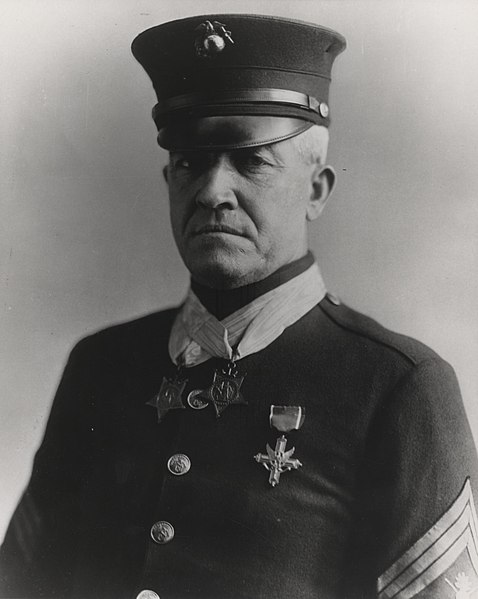 , a recipient of two Medals of Honor who had served in the Philippines, Santo Domingo, Haiti, Peking and Vera Cruz, prompted his men of the 73rd Machine Gun company forward with the words: "Come on, you sons of bitches, do you want to live forever?
, a recipient of two Medals of Honor who had served in the Philippines, Santo Domingo, Haiti, Peking and Vera Cruz, prompted his men of the 73rd Machine Gun company forward with the words: "Come on, you sons of bitches, do you want to live forever?
 , a recipient of two Medals of Honor who had served in the Philippines, Santo Domingo, Haiti, Peking and Vera Cruz, prompted his men of the 73rd Machine Gun company forward with the words: "Come on, you sons of bitches, do you want to live forever?
, a recipient of two Medals of Honor who had served in the Philippines, Santo Domingo, Haiti, Peking and Vera Cruz, prompted his men of the 73rd Machine Gun company forward with the words: "Come on, you sons of bitches, do you want to live forever?
The first waves of Marines—advancing in well-disciplined lines—were slaughtered; Major Berry was wounded in the forearm during the advance. On his right, the Marines of Major Meyer's 3/6 Battalion swept into the southern end of Belleau Wood and encountered heavy machine gun fire, sharpshooters and barbed wire. Marines and German infantrymen were soon engaged in heavy hand-to-hand fighting. The casualties sustained on this day were the highest in Marine Corps history to that time. Some 31 officers and 1,056 men of the Marine brigade were casualties. However, the Marines now had a foothold in Belleau Wood.

The battle was now deadlocked. At midnight on 7–8 June, a German attack was stopped cold and an American counter-attack in the morning of 8 June was similarly defeated. Meyer's battalion—having sustained nearly 400 casualties—was relieved by the 1st Battalion, 6th Marines. Major Shearer took over the 3rd Battalion, 5th Marines for the wounded Berry. On 9 June, an enormous American and French barrage devastated Belleau Wood, turning the formerly attractive hunting preserve into a jungle of shattered trees. The Germans counter-fired into Lucy and Bouresches and reorganized their defenses inside Belleau Wood

Map showing location of Marine push to secure Belleau Wood, 25 June 1918In the morning of 10 June, Maj. Hughes' 1st Battalion, 6th Marines—together with elements of the 6th Machine Gun Battalion—attacked north into the wood. Although this attack initially seemed to be succeeding, it was also stopped by machine gun fire. The commander of the 6th Machine Gun Battalion—Major Cole—was mortally wounded. Captain Harlan Major—senior captain present with the battalion—took command. The Germans used great quantities of mustard gas. Next, Wise's 2nd Battalion, 5th Marines was ordered to attack the woods from the west, while Hughes continued his advance from the south

At 04:00 on 11 June, Wise's men advanced through a thick morning mist towards Belleau Wood, supported by the 23rd and 77th Companies of the 6th Machine Gun Battalion, and were cut to pieces by heavy fire. Platoons were isolated and destroyed by interlocked machine gun fire. It was discovered that the battalion had advanced in the wrong direction. Rather than moving northeast, they had moved directly across the wood's narrow waist. However, they smashed the German southern defensive lines. A German private, whose company had 30 men left out of 120, wrote "We have Americans opposite us who are terribly reckless fellows."
Overall, the woods were attacked by the Marines a total of six times before they could successfully expel the Germans. They fought off parts of five divisions of Germans, often reduced to using only their bayonets or fists in hand-to-hand combat.
On 26 June, the 3rd Battalion, 5th Marines, under command of Major Maurice E. Shearer, supported by two companies of the 4th Machine Gun Battalion and the 15th Company of the 6th Machine Gun Battalion, made an attack on Belleau Wood, which finally cleared that forest of the enemy.[ On that day, Major Shearer submitted a report simply stating, "Woods now U.S. Marine Corps entirely,"ending one of the bloodiest and most ferocious battles U.S. forces would fight in the war.U.S. forces suffered 9,777 casualties, included 1,811 killed.[1] Many are buried in the nearby Aisne-Marne American Cemetery. There is no clear information on the number of Germans killed, although 1,600 Germans were taken prisoner.
After the battle, the French renamed the wood "Bois de la Brigade de Marine" ("Wood of the Marine Brigade") in honor of the Marines' tenacity. The French government also later awarded the 4th Brigade the Croix de guerre. An official German report classified the Marines as "vigorous, self-confident, and remarkable marksmen..." General Pershing—Commander of the AEF—even said, "The deadliest weapon in the world is a Marine and his rifle!" Pershing also said "the Battle of Belleau Wood was for the U.S. the biggest battle since Appomattox and the most considerable engagement American troops had ever had with a foreign enemy."

In spite of the legend, it is unlikely that the Germans ever used the term "Teufelshunde" for the Marines, as the term was not known in contemporary German. The closest common German term would be "Höllenhunde" which means "hellhound". Though the meanings are similar, neither of these terms has been found in any German documents of the time.
In 1923, an American battle monument was built in Belleau Wood. Army General James. G. Harbord—the commander of the Marines during the battle—was made an honorary Marine. In his address, he summed up the future of the site:
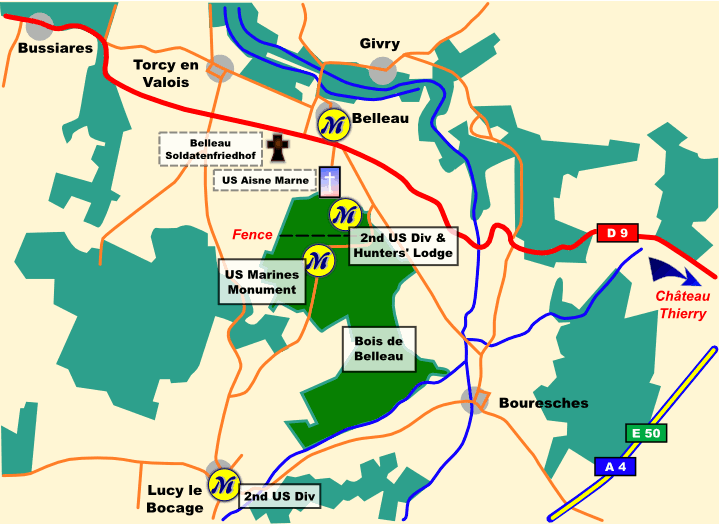
"Now and then, a veteran ... will come here to live again the brave days of that distant June. Here will be raised the altars of patriotism; here will be renewed the vows of sacrifice and consecration to country. Hither will come our countrymen in hours of depression, and even of failure, and take new courage from this shrine of great deeds."
White crosses and Stars of David mark 2,289 graves, 250 for unknown service members, and the names of 1,060 missing men adorn the wall of a memorial chapel. Visitors also stop at the nearby German cemetery where 8,625 men are buried; 4,321 of them—3,847 unknown—rest in a common grave. The German cemetery was established in March 1922, consolidating a number of temporary sites, and includes men killed between the Aisne and the Marne in 1918, along with 70 men who died in 1914 in the First Battle of the Marne.
In New York City, a 0.197 acres (800 m2) triangle at the intersection of 108 Street and 51st Avenue in Queens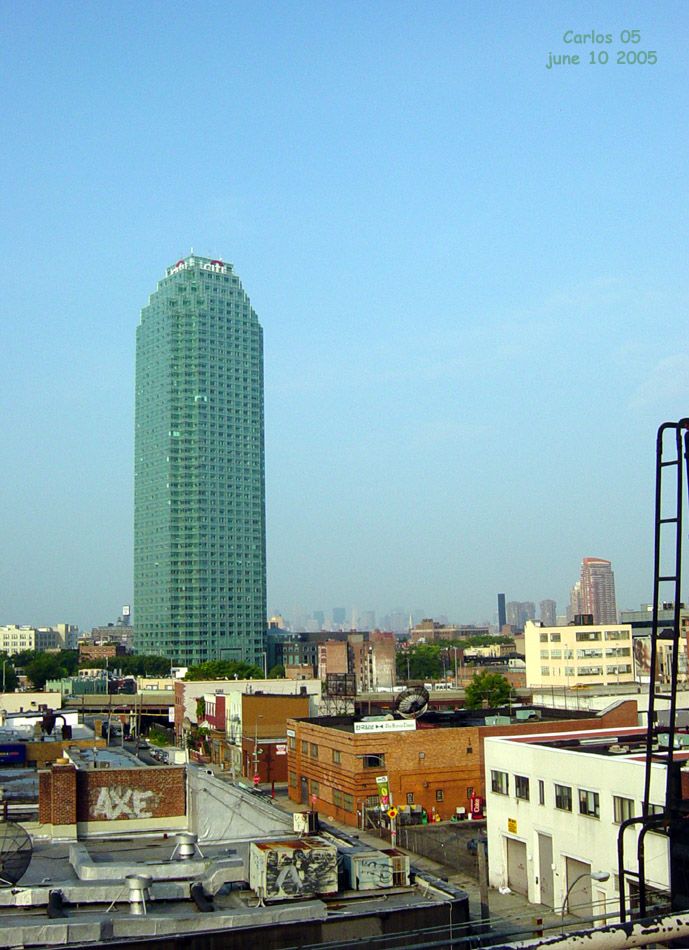 is dedicated to Marine Pvt.William F. Moore, 47th Company, 2nd Battalion, 5th Marine Regiment.
is dedicated to Marine Pvt.William F. Moore, 47th Company, 2nd Battalion, 5th Marine Regiment.
The Fifth and Sixth Marine Regiments were awarded the French Fourragère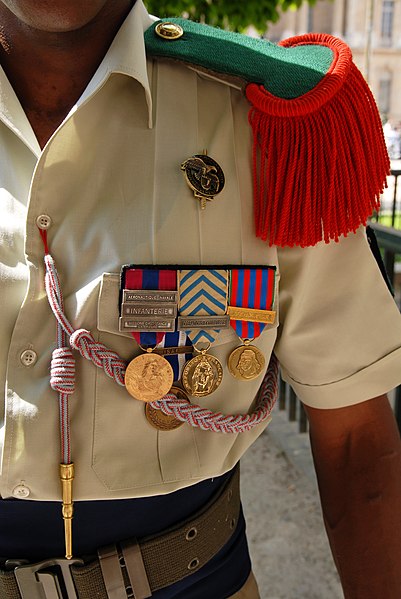 for their actions at Belleau Wood.Two U.S. Navy vessels have been named the USS Belleau Wood
for their actions at Belleau Wood.Two U.S. Navy vessels have been named the USS Belleau Wood (CVL-24 and LHA-3) after the battle.
(CVL-24 and LHA-3) after the battle.
 is dedicated to Marine Pvt.William F. Moore, 47th Company, 2nd Battalion, 5th Marine Regiment.
is dedicated to Marine Pvt.William F. Moore, 47th Company, 2nd Battalion, 5th Marine Regiment.The Fifth and Sixth Marine Regiments were awarded the French Fourragère
 for their actions at Belleau Wood.Two U.S. Navy vessels have been named the USS Belleau Wood
for their actions at Belleau Wood.Two U.S. Navy vessels have been named the USS Belleau Wood (CVL-24 and LHA-3) after the battle.
(CVL-24 and LHA-3) after the battle."Belleau Wood" is a song released by American Country Music artist Garth Brooks. It was the 14th track from his 1997 album Sevens.
Lloyd Williams' famous quote is the basis for the motto of his unit, the 2nd Battalion, 5th Marines. Williams himself has been honored with a building on the campus of his alma mater Virginia Polytechnic Institute and State University named in remembrance of h
Subscribe to:
Posts (Atom)















